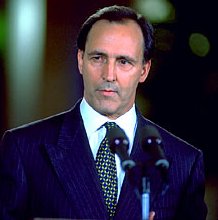 Right: Former Prime Minister Paul Keating, who pegged the price of tobacco products to the Consumer price index.
Right: Former Prime Minister Paul Keating, who pegged the price of tobacco products to the Consumer price index.
 Found a word you're not familiar with? Double-click that word to bring up a dictionary reference to it. The dictionary page includes an audio sound file with which to actually hear the word said. Found a word you're not familiar with? Double-click that word to bring up a dictionary reference to it. The dictionary page includes an audio sound file with which to actually hear the word said. |
 Background information
Background information
Tobacco taxes in Australia
Tobacco taxes are favoured by governments because of their relatively low level of unpopularity with voters and because of their low administrative costs relative to the income they generate.
A variety of taxes are applied to cigarettes and other tobacco products internationally. Virtually all countries apply excise duty specified as an amount payable per x number of cigarette sticks. A small number of countries charge excise payable per x grams of tobacco weight.
Federal excise and customs duty
The federal government has imposed excise duty on Australian-made and customs duty on imported tobacco products since the passage in 1901 of the Excise Act and the Customs Act. Prior to federation, the colonies imposed their own tariffs.
Until 1999, federal excise and customs duty was calculated on the basis of the weight of tobacco products. The Excise Regulations 1925 specified precisely how manufacturers needed to label, calculate and declare excise duty. These also specified how the weight of tobacco products (and the volume of alcohol and petroleum products) was to be calculated. For cigarettes, this included the weight of filter and paper, but not the weight of the packaging.
In the early years of last century, manufactured tobacco was charged at a rate of one shilling per pound (of product weight) and cigars were taxed at one shilling and sixpence per pound. Since 1920, the rate of the duty has been set out in (frequently amended) schedules to the Excise Tariff Act passed in 1921. Historically, duty on tobacco in cigarettes was levied at a higher rate than duty on non-cigarette tobacco.
In November 1983, the then federal treasurer, the Hon. Paul Keating, changed customs and excise policy in several ways. First, the rate of federal excise and customs duty was linked with the Australian Consumer Price Index (CPI), meaning that since that time, excise and customs duty have automatically increased in February and August each year in line with the CPI for the six months to the previous December and June. Second, the rate of duty for cigars was immediately made equal to that of cigarettes. Third, the rate for non-cigarette tobacco was increased by $5 a kilo. In subsequent budgets the rate for smoking tobacco was increased further (by another $5 a kilo in the 1984 and 1985 budgets, and then by $1.90 in the 1986 budget).
Throughout the 1990s, health groups lobbied for increases in federal excise duty. In addition to the six-monthly CPI increases, the government increased the rate of federal excise applicable to cigarettes and other tobacco products on several occasions. These included a $5 per kilo increase in 1992 and increases announced in the 1993 budget of 3% in August 1993 and 5% in February and August 1994 and February 1995. The final increment rise of 5% planned for August 1995 was brought forward and increased to an immediate 10% rise in the Federal Budget handed down on 10 May 1995.
State tobacco licence fees
In November 1974 Victoria became the first Australian jurisdiction to introduce a licence fee (known as a business franchise fee) on the sale of tobacco products. The business franchise fee on tobacco had two components. The first was a set amount charged each year. The second was an amount based on the value of tobacco sold in the immediately preceding month. The monthly (variable) rate was set at 2.5% in 1974 increasing to 10% in 1975. Between 1975 and 1989, all state and territory governments introduced similar fees.
The fixed licence fee and the percentage levy varied from state to state. Generally the fees were forwarded to state or territory government revenue collection offices by tobacco wholesalers; however, if retailers purchased stock from suppliers other than licensed wholesalers, they also were required to pay both the set and the variable licence fees. The percentage component was by far the more lucrative for governments, and the rate of the levy was frequently increased in all jurisdictions, sometimes more than once within the same budget period.
